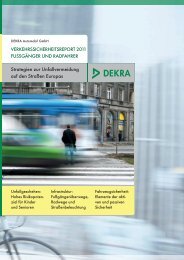PRIORITIES FOR EU MOTOR VEHICLE SAFETY DESIGN
priorities for eu motor vehicle safety design - ETSC
priorities for eu motor vehicle safety design - ETSC
You also want an ePaper? Increase the reach of your titles
YUMPU automatically turns print PDFs into web optimized ePapers that Google loves.
enable a further review of the Directive to be made to enable the higher speeds of impact<br />
in accidents to be addressed.<br />
e) Urgent consideration needs to be given to instrumenting all the load paths into the<br />
EuroSID dummy and developing criteria for them.<br />
f) In any future side impact dummy, all possible load paths need to be instrumented by<br />
design.<br />
g) When the EEVC research is complete, a single design specification of barrier face<br />
should be specified in the Directive. This barrier face must be capable of being<br />
manufactured to the same standard of performance by competing suppliers around the<br />
world.<br />
h) A pole impact test is required to evaluate head protection in side impact. Consideration<br />
should be given to the development of a test to simulate accidents involving impacts with<br />
poles. This would require research into the levels of protection possible.<br />
3. Improving car to car compatibility<br />
a) Compatibility is seen as the next major step forward in improving car occupant safety.<br />
Further developments of frontal impact protection need to be considered in association<br />
with compatibility and this is seen as a top priority for vehicle safety research.<br />
4. Improving seat belt use<br />
a) The fitment of effective seat belt reminder systems is seen as a high priority for early<br />
action.<br />
b) EuroNCAP can provide an immediate incentive for manufacturers to develop and install<br />
simple effective seat belt reminder systems and then to continue to develop more<br />
advanced ones.<br />
c) When effective seat belt reminder systems become available, consideration should be<br />
given to enacting legislation for their mandatory fitment.<br />
5. Frontal protection front air bags<br />
a) Driver airbags should be fitted universally.<br />
b) Where passenger airbags are fitted, clear instructions are needed to avoid the fitment of<br />
rearward facing child restraints on the seat.<br />
c) The provision of automatic detection of child restraints and out of position occupants is<br />
needed to switch off the passenger airbag.<br />
d) If manual switches are provided, an effective warning about their setting needs to be<br />
incorporated.<br />
6. Side protection air bags<br />
a) With the growing number of side airbags fitted in cars, accident research is needed to<br />
identify their benefits and any associated problems.<br />
7. Restraint of children in cars<br />
a) Children in cars should be provided with suitable child restraints for their age and size.<br />
b) The use of rearward facing restraints provides the best protection and should be used up<br />
to as high an age as possible.<br />
c) Further research is needed to assess the effects of modern car designs to identify<br />
necessary changes for restraint design and regulatory tests.<br />
d) A mandatory side impact test procedure is required to assess child restraints for all age<br />
groups of children.<br />
e) The fitting of ISOFIX anchorages, with provision for an effective third restraint in the front<br />
and rear seats should be made mandatory.<br />
f) ECE R44 should be developed to assess universal ISOFIX seats, with effective third<br />
restraints.<br />
53



